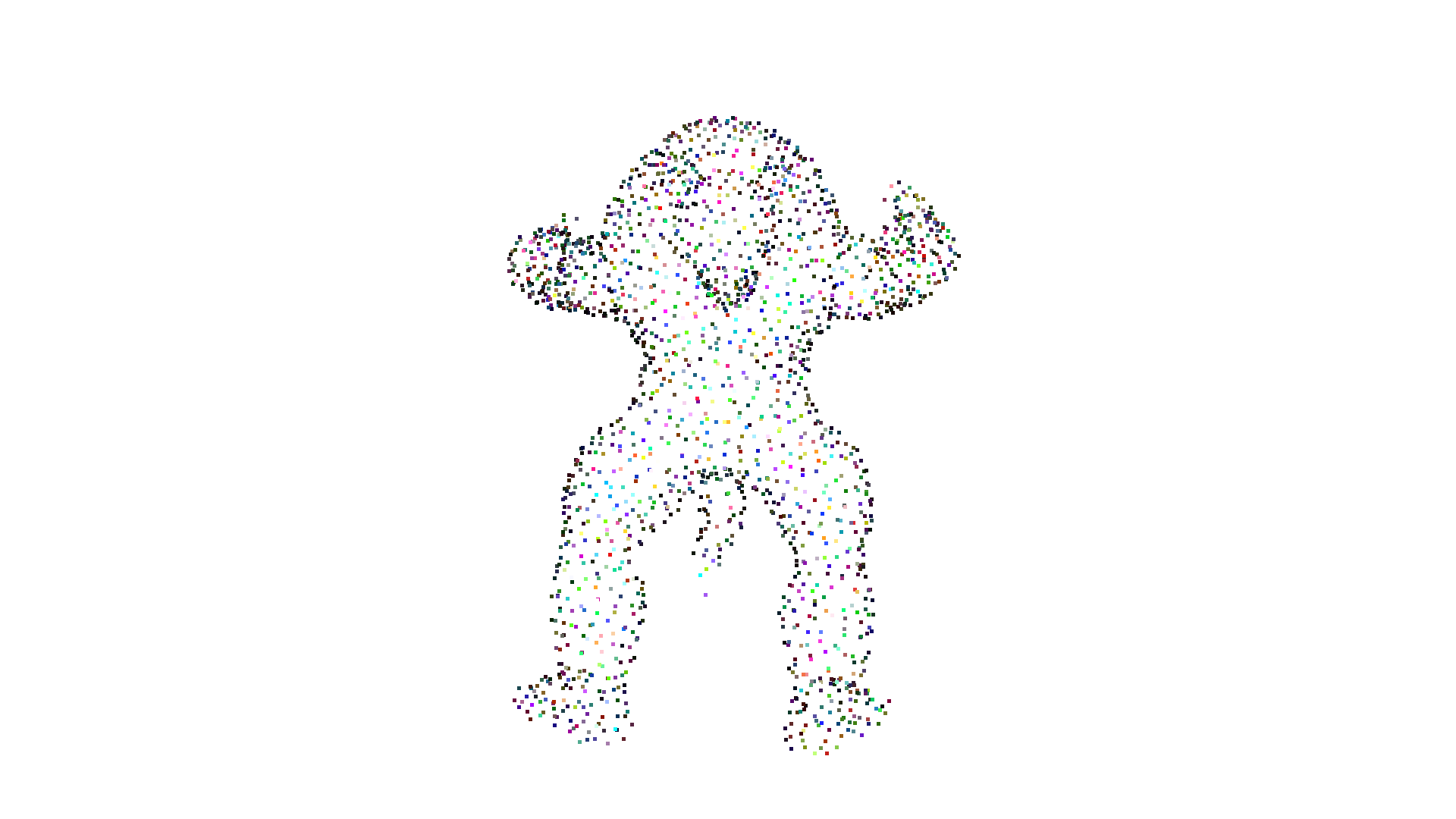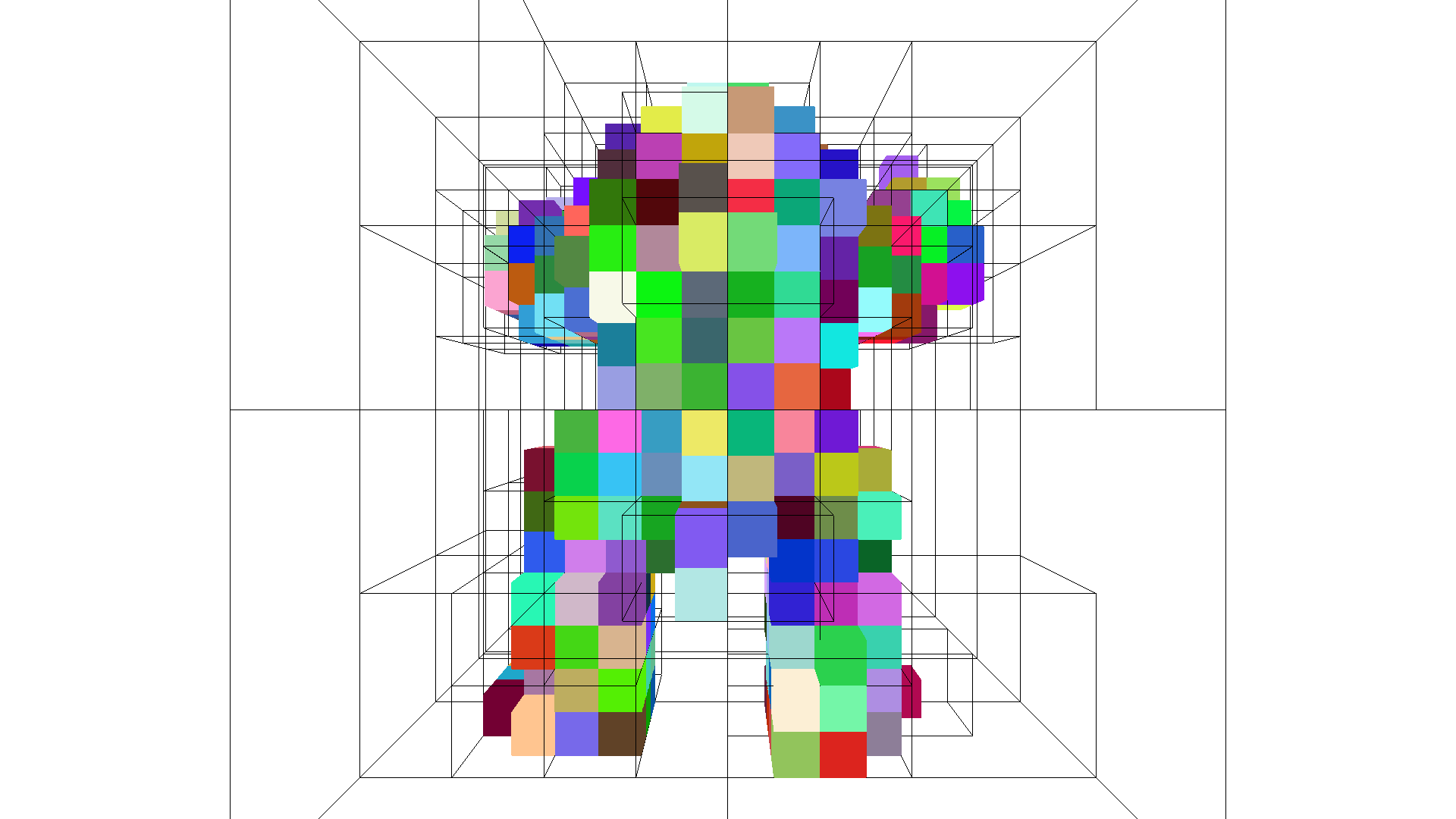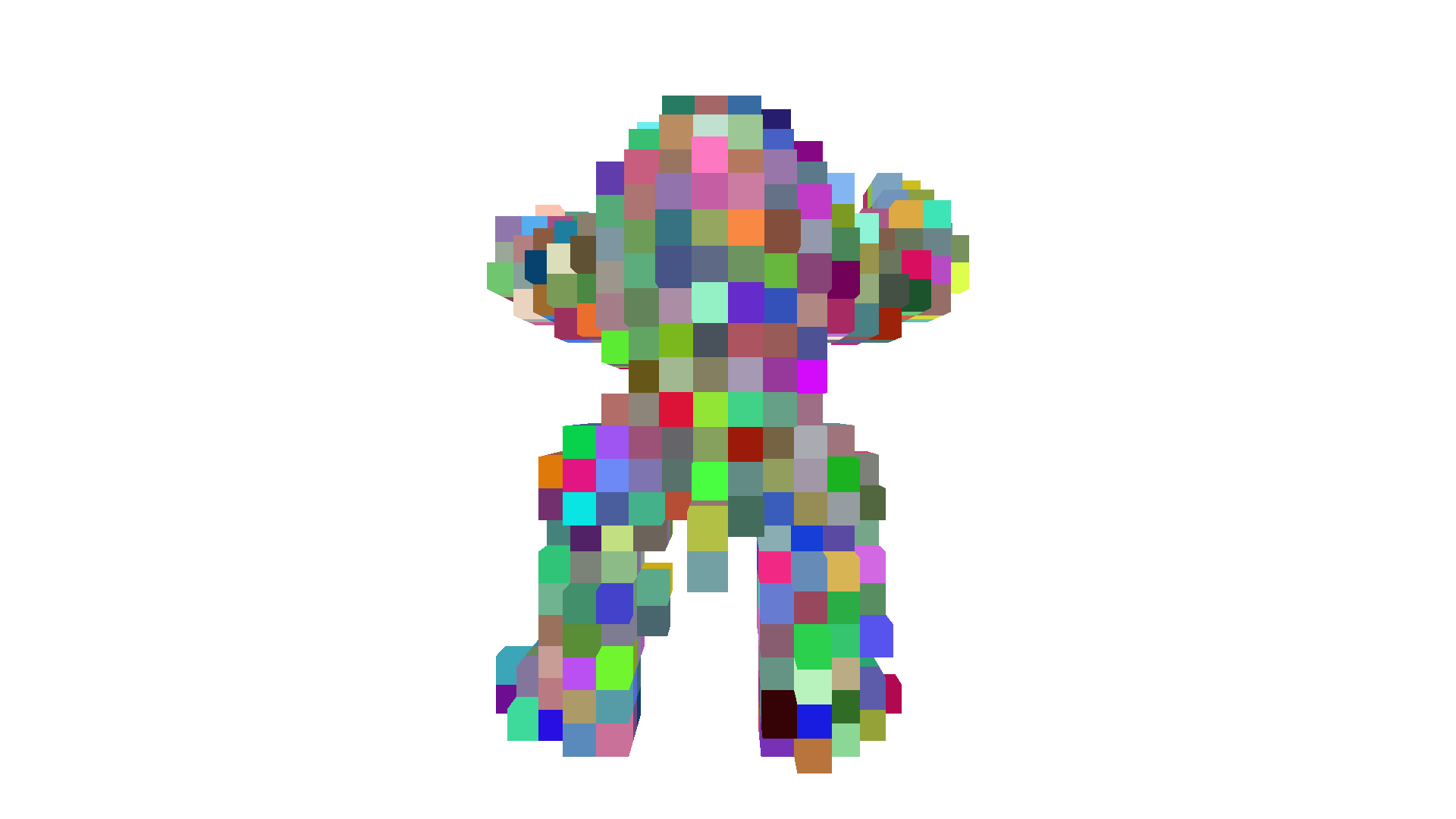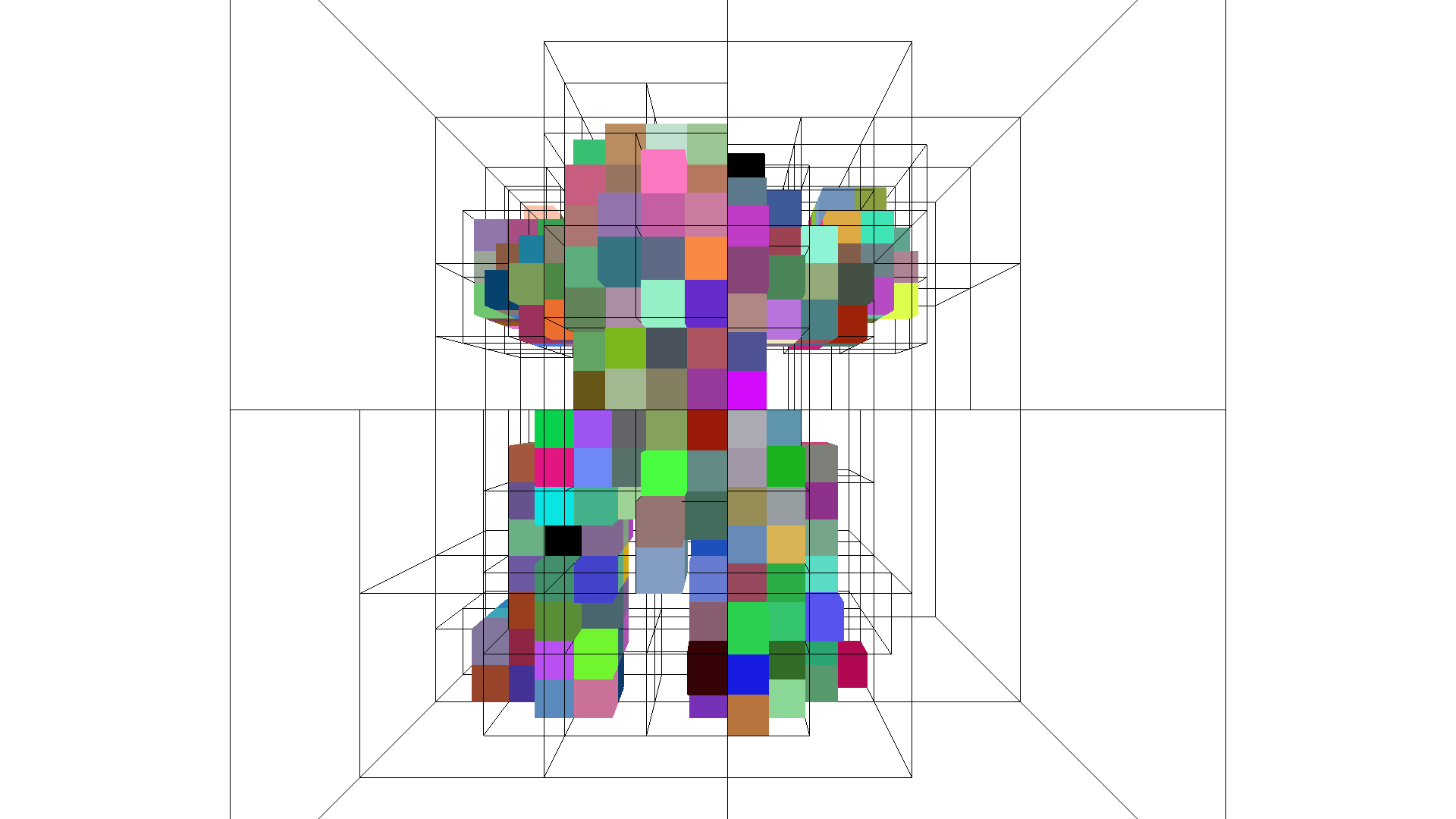Octree¶
An octree is a tree data structure where each internal node has eight children. Octrees are commonly used for spatial partitioning of 3D point clouds. Non-empty leaf nodes of an octree contain one or more points that fall within the same spatial subdivision. Octrees are a useful description of 3D space and can be used to quickly find nearby points. Open3D has the geometry type Octree that can be used to create, search, and traverse octrees with a user-specified maximum tree depth,
max_depth.
From point cloud¶
An octree can be constructed from a point cloud using the method convert_from_point_cloud. Each point is inserted into the tree by following the path from the root node to the appropriate leaf node at depth max_depth. As the tree depth increases, internal (and eventually leaf) nodes represents a smaller partition of 3D space.
If the point cloud has color, the the corresponding leaf node takes the color of the last inserted point. The size_expand parameter increases the size of the root octree node so it is slightly bigger than the original point cloud bounds to accomodate all points.
[2]:
print('input')
N = 2000
pcd = o3dtut.get_armadillo_mesh().sample_points_poisson_disk(N)
# fit to unit cube
pcd.scale(1 / np.max(pcd.get_max_bound() - pcd.get_min_bound()),
center=pcd.get_center())
pcd.colors = o3d.utility.Vector3dVector(np.random.uniform(0, 1, size=(N, 3)))
o3d.visualization.draw_geometries([pcd])
print('octree division')
octree = o3d.geometry.Octree(max_depth=4)
octree.convert_from_point_cloud(pcd, size_expand=0.01)
o3d.visualization.draw_geometries([octree])
input
downloading armadillo mesh
extract armadillo mesh

octree division

From voxel grid¶
An octree can also be constructed from an Open3D VoxelGrid geometry using the method create_from_voxel_grid. Each voxel of the input VoxelGrid is treated as a point in 3D space with coordinates corresponding to the origin of the voxel. Each leaf node takes the color of its corresponding voxel.
[3]:
print('voxelization')
voxel_grid = o3d.geometry.VoxelGrid.create_from_point_cloud(pcd,
voxel_size=0.05)
o3d.visualization.draw_geometries([voxel_grid])
print('octree division')
octree = o3d.geometry.Octree(max_depth=4)
octree.create_from_voxel_grid(voxel_grid)
o3d.visualization.draw_geometries([octree])
voxelization

octree division

Additionally, an Octree can be coverted to a VoxelGrid with to_voxel_grid.
Traversal¶
An octree can be traversed which can be useful for searching or processing subsections of 3D geometry. By providing the traverse method with a callback, each time a node (internal or leaf) is visited, additional processing can be performed.
In the following example, an early stopping criterion is used to only process internal/leaf nodes with more than a certain number of points. This early stopping ability can be used to efficiently process spatial regions meeting certain conditions.
[4]:
def f_traverse(node, node_info):
early_stop = False
if isinstance(node, o3d.geometry.OctreeInternalNode):
if isinstance(node, o3d.geometry.OctreeInternalPointNode):
n = 0
for child in node.children:
if child is not None:
n += 1
print(
"{}{}: Internal node at depth {} has {} children and {} points ({})"
.format(' ' * node_info.depth,
node_info.child_index, node_info.depth, n,
len(node.indices), node_info.origin))
# we only want to process nodes / spatial regions with enough points
early_stop = len(node.indices) < 250
elif isinstance(node, o3d.geometry.OctreeLeafNode):
if isinstance(node, o3d.geometry.OctreePointColorLeafNode):
print("{}{}: Leaf node at depth {} has {} points with origin {}".
format(' ' * node_info.depth, node_info.child_index,
node_info.depth, len(node.indices), node_info.origin))
else:
raise NotImplementedError('Node type not recognized!')
# early stopping: if True, traversal of children of the current node will be skipped
return early_stop
[5]:
octree = o3d.geometry.Octree(max_depth=4)
octree.convert_from_point_cloud(pcd, size_expand=0.01)
octree.traverse(f_traverse)
0: Internal node at depth 0 has 8 children and 2000 points ([-2.5296415 30.57793351 2.22678118])
0: Internal node at depth 1 has 4 children and 65 points ([-2.5296415 30.57793351 2.22678118])
1: Internal node at depth 1 has 2 children and 45 points ([-2.0246415 30.57793351 2.22678118])
2: Internal node at depth 1 has 8 children and 402 points ([-2.5296415 31.08293351 2.22678118])
0: Internal node at depth 2 has 2 children and 5 points ([-2.5296415 31.08293351 2.22678118])
1: Internal node at depth 2 has 1 children and 5 points ([-2.2771415 31.08293351 2.22678118])
2: Internal node at depth 2 has 4 children and 43 points ([-2.5296415 31.33543351 2.22678118])
3: Internal node at depth 2 has 1 children and 5 points ([-2.2771415 31.33543351 2.22678118])
4: Internal node at depth 2 has 4 children and 55 points ([-2.5296415 31.08293351 2.47928118])
5: Internal node at depth 2 has 5 children and 96 points ([-2.2771415 31.08293351 2.47928118])
6: Internal node at depth 2 has 4 children and 72 points ([-2.5296415 31.33543351 2.47928118])
7: Internal node at depth 2 has 6 children and 121 points ([-2.2771415 31.33543351 2.47928118])
3: Internal node at depth 1 has 7 children and 363 points ([-2.0246415 31.08293351 2.22678118])
0: Internal node at depth 2 has 1 children and 5 points ([-2.0246415 31.08293351 2.22678118])
2: Internal node at depth 2 has 1 children and 6 points ([-2.0246415 31.33543351 2.22678118])
3: Internal node at depth 2 has 4 children and 11 points ([-1.7721415 31.33543351 2.22678118])
4: Internal node at depth 2 has 4 children and 82 points ([-2.0246415 31.08293351 2.47928118])
5: Internal node at depth 2 has 3 children and 46 points ([-1.7721415 31.08293351 2.47928118])
6: Internal node at depth 2 has 6 children and 105 points ([-2.0246415 31.33543351 2.47928118])
7: Internal node at depth 2 has 6 children and 108 points ([-1.7721415 31.33543351 2.47928118])
4: Internal node at depth 1 has 5 children and 347 points ([-2.5296415 30.57793351 2.73178118])
0: Internal node at depth 2 has 4 children and 60 points ([-2.5296415 30.57793351 2.73178118])
1: Internal node at depth 2 has 4 children and 103 points ([-2.2771415 30.57793351 2.73178118])
2: Internal node at depth 2 has 2 children and 22 points ([-2.5296415 30.83043351 2.73178118])
3: Internal node at depth 2 has 8 children and 141 points ([-2.2771415 30.83043351 2.73178118])
7: Internal node at depth 2 has 1 children and 21 points ([-2.2771415 30.83043351 2.98428118])
5: Internal node at depth 1 has 4 children and 325 points ([-2.0246415 30.57793351 2.73178118])
0: Internal node at depth 2 has 8 children and 178 points ([-2.0246415 30.57793351 2.73178118])
1: Internal node at depth 2 has 1 children and 1 points ([-1.7721415 30.57793351 2.73178118])
2: Internal node at depth 2 has 8 children and 143 points ([-2.0246415 30.83043351 2.73178118])
6: Internal node at depth 2 has 1 children and 3 points ([-2.0246415 30.83043351 2.98428118])
6: Internal node at depth 1 has 6 children and 234 points ([-2.5296415 31.08293351 2.73178118])
7: Internal node at depth 1 has 5 children and 219 points ([-2.0246415 31.08293351 2.73178118])
Find leaf node containing point¶
Using the above traversal mechanism, an octree can be quickly searched for the leaf node that contains a given point. This functionality is provided via the locate_leaf_node method.
[6]:
octree.locate_leaf_node(pcd.points[0])
[6]:
(OctreePointColorLeafNode with color [0.611293, 0.0542197, 0.503748] containing 4 points.,
OctreeNodeInfo with origin [-1.96152, 31.1461, 2.79491], size 0.063125, depth 4, child_index 7)